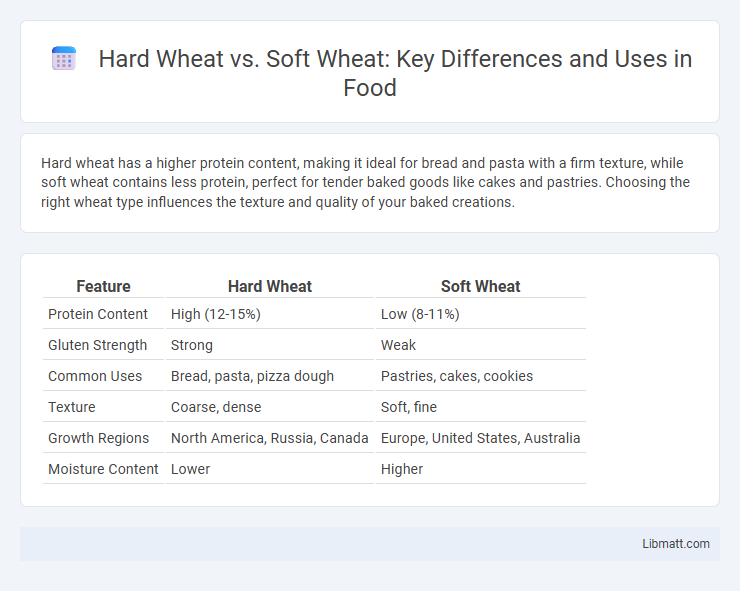Hard wheat has a higher protein content, making it ideal for bread and pasta with a firm texture, while soft wheat contains less protein, perfect for tender baked goods like cakes and pastries. Choosing the right wheat type influences the texture and quality of your baked creations.
Table of Comparison
| Feature | Hard Wheat | Soft Wheat |
|---|---|---|
| Protein Content | High (12-15%) | Low (8-11%) |
| Gluten Strength | Strong | Weak |
| Common Uses | Bread, pasta, pizza dough | Pastries, cakes, cookies |
| Texture | Coarse, dense | Soft, fine |
| Growth Regions | North America, Russia, Canada | Europe, United States, Australia |
| Moisture Content | Lower | Higher |
Introduction to Hard Wheat and Soft Wheat
Hard wheat contains a higher protein content, making it ideal for bread, pasta, and products requiring strong gluten development. Soft wheat has lower protein levels, which contributes to a tender, flaky texture, perfect for cakes, pastries, and cookies. You can select between hard and soft wheat varieties based on the desired texture and baking requirements of your recipes.
Key Differences Between Hard Wheat and Soft Wheat
Hard wheat contains higher protein content, typically ranging from 11% to 15%, making it ideal for bread and pasta due to its strong gluten structure. Soft wheat has lower protein levels, around 7% to 10%, resulting in a finer texture suited for cakes, pastries, and cookies. Your choice between hard and soft wheat impacts the texture, elasticity, and rise of baked goods.
Grain Structure and Texture Comparison
Hard wheat contains higher protein content with dense, firm kernels, resulting in a coarser grain structure ideal for bread and pasta production. Soft wheat has lower protein levels and a finer, softer kernel texture, making it perfect for cakes, pastries, and other tender baked goods. Understanding the differences in grain structure helps you choose the right wheat type for specific culinary purposes.
Protein and Gluten Content in Hard vs Soft Wheat
Hard wheat contains higher protein and gluten content compared to soft wheat, making it ideal for bread and pasta that require strong dough elasticity. Soft wheat has lower protein levels and less gluten, resulting in a tender crumb perfect for pastries, cakes, and cookies. Understanding these differences helps you choose the right wheat type for your baking needs, ensuring optimal texture and structure.
Culinary Uses: Best Applications for Each Type
Hard wheat, rich in protein and gluten, is ideal for bread, pasta, and other products requiring strong structure and elasticity. Soft wheat, with lower protein content and finer texture, excels in cakes, pastries, and cookies where tenderness and crumbly texture are desired. Choosing the right wheat type enhances baking performance and final product quality based on specific culinary needs.
Nutritional Profiles: Hard Wheat vs Soft Wheat
Hard wheat contains higher protein content, typically ranging from 12% to 15%, making it ideal for bread and pasta due to its strong gluten formation. Soft wheat has lower protein levels, around 8% to 11%, resulting in a finer texture perfect for cakes, pastries, and cookies. Your choice between hard wheat and soft wheat affects the nutritional profile and texture of the baked goods you prepare.
Milling Process Variations
Hard wheat and soft wheat undergo distinct milling process variations due to their differing protein content and kernel hardness. Hard wheat, with higher protein and stronger gluten, requires more intensive grinding to produce coarse flour ideal for bread and pasta, while soft wheat's lower protein content and softer texture allow for gentler milling, yielding fine, tender flour suited for cakes and pastries. Your choice of wheat impacts the milling techniques applied to achieve the desired flour quality and baking performance.
Baking Performance and End Products
Hard wheat contains higher protein levels, primarily gluten, resulting in stronger dough ideal for bread, pizza crusts, and pasta with firm texture. Soft wheat has lower protein and gluten content, producing tender, crumbly baked goods such as cakes, pastries, and cookies. The distinct gluten strength in hard versus soft wheat directly influences dough elasticity, rise, and final product texture.
Regional Growth and Global Production
Hard wheat predominantly grows in the Great Plains of the United States and Canada, with significant production also in Russia and Australia, due to its suitability for bread-making and pasta industries. Soft wheat thrives in regions like the European Union, the U.S. Pacific Northwest, and parts of China, favored for pastry and biscuit production because of its lower protein content. Your global supply decisions should consider that hard wheat accounts for approximately 70% of worldwide wheat production, reflecting its higher demand in staple food manufacturing.
Choosing the Right Wheat for Your Needs
Hard wheat contains higher protein content, making it ideal for bread, pasta, and other products that require strong gluten development for structure and chewiness. Soft wheat has lower protein levels, providing a fine texture perfect for pastries, cakes, and cookies where tenderness and crumb are desired. Selecting the right wheat depends on the desired texture and baking properties, with hard wheat favoring elasticity and rise, while soft wheat supports delicate and crumbly baked goods.
Hard Wheat vs Soft Wheat Infographic

 libmatt.com
libmatt.com